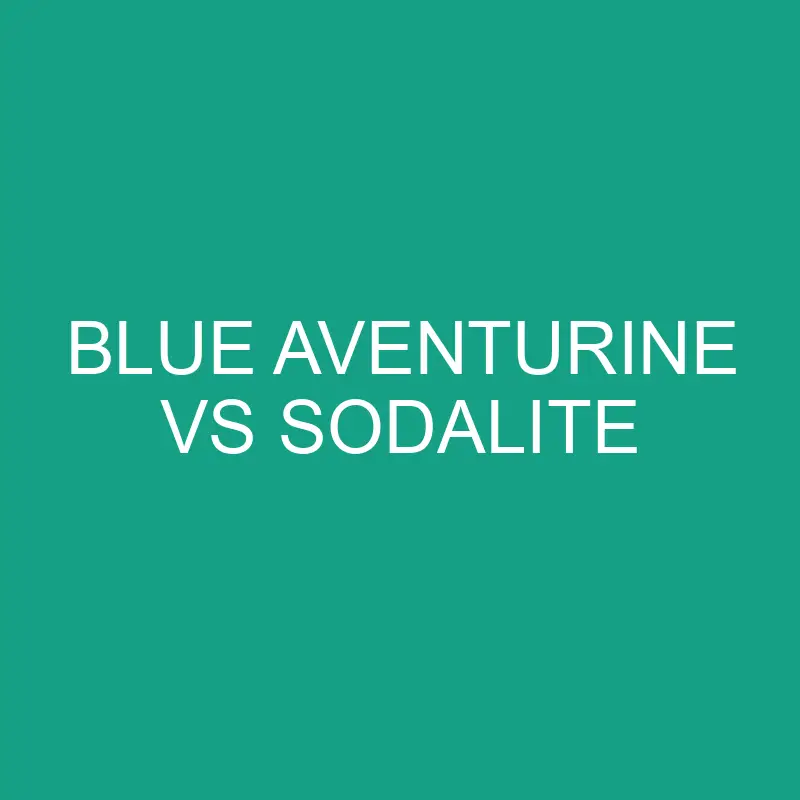Blue aventurine and sodalite are both beautiful blue gemstones, but they have distinct mineral compositions, properties, and appearances. Let’s explore the differences between blue aventurine and sodalite.
Post Contents
Blue Aventurine:
Origins and Geology:
- Origins: Aventurine is a form of quartz, and blue aventurine gets its color from inclusions of blue minerals like fuchsite, dumortierite, or blue quartz. It is found in various locations, including India, Brazil, Russia, and Spain.
Physical Properties:
- Color: Blue aventurine ranges from light to dark blue, often with a sparkling or shimmering effect due to mineral inclusions.
- Transparency: It can be translucent to opaque.
- Luster: Blue aventurine has a vitreous (glassy) to pearly luster.
- Mohs Scale: Aventurine has a hardness of 6.5 to 7 on the Mohs scale.
Uses:
- Jewelry: Blue aventurine is used in jewelry, including beads, cabochons, and pendants.
- Decorative Items: It is also used in ornamental items, carvings, and sculptures.
Metaphysical Properties:
- Calming Energy: Blue aventurine is believed to have calming and soothing energies.
- Throat Chakra: It is associated with the throat chakra and is thought to aid in communication.
Sodalite:
Origins and Geology:
- Origins: Sodalite is a rich royal blue mineral and is usually found in igneous rocks, particularly in limestones altered by sodium-rich fluids. Major deposits are found in Brazil, Canada, Namibia, and Russia.
Physical Properties:
- Color: Sodalite is typically deep blue with white or gray streaks. It may also contain orange calcite inclusions.
- Transparency: It is usually translucent to opaque.
- Luster: Sodalite has a vitreous to greasy luster.
- Mohs Scale: Sodalite has a hardness of 5.5 to 6 on the Mohs scale.
Uses:
- Jewelry: Sodalite is used in jewelry, especially for beads and cabochons.
- Carvings and Sculptures: It is popular for carvings and sculptures due to its rich color.
- Decorative Items: Sodalite is used in decorative items like vases and bowls.
Metaphysical Properties:
- Logic and Intuition: Sodalite is associated with logic, intuition, and enhancing one’s mental abilities.
- Throat and Third Eye Chakras: It is believed to align with the throat and third eye chakras, aiding in communication and intuition.
Blue Aventurine vs. Sodalite: Key Differences
Color:
- Blue Aventurine: Ranges from light to dark blue with a sparkling effect.
- Sodalite: Deep blue with white or gray streaks, and sometimes orange calcite inclusions.
Luster:
- Blue Aventurine: Vitreous to pearly.
- Sodalite: Vitreous to greasy.
Transparency:
- Blue Aventurine: Translucent to opaque.
- Sodalite: Translucent to opaque.
Mohs Scale:
- Blue Aventurine: Hardness of 6.5 to 7.
- Sodalite: Hardness of 5.5 to 6.
Uses:
- Blue Aventurine: Used in jewelry and decorative items.
- Sodalite: Used in jewelry, carvings, sculptures, and decorative items.
Metaphysical Associations:
- Blue Aventurine: Associated with calming energy and the throat chakra.
- Sodalite: Linked to logic, intuition, and alignment with the throat and third eye chakras.
Conclusion:
Blue aventurine and sodalite are both captivating blue gemstones, each with its own unique characteristics and metaphysical properties. Blue aventurine is known for its calming energies and the sparkling effect created by mineral inclusions. Sodalite, on the other hand, is prized for its deep blue color with streaks of white or gray, and it is associated with enhancing mental abilities and intuition. The choice between the two depends on individual preferences, the intended use, and the specific metaphysical qualities one is seeking in a gemstone. Both stones contribute to the diversity and beauty of the world of gemstones and minerals.

